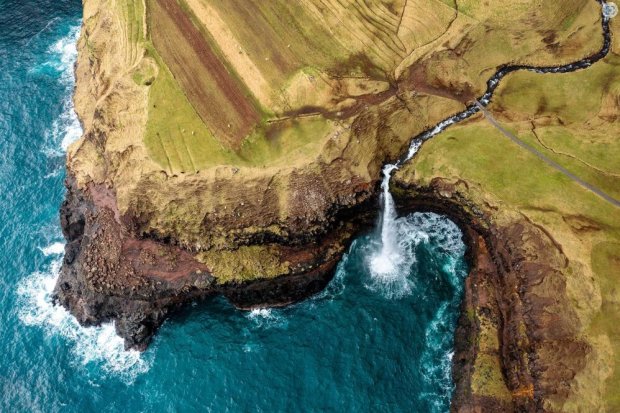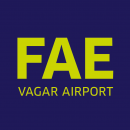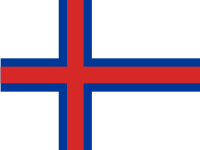National Geographic Traveller: Why The Faroe Islands Should Be Your Next Road Trip Destination
 Credit: Alamy Images; Westend61 GmbH
Credit: Alamy Images; Westend61 GmbH
Drive the Faroe Islands’ scenic byways to get lost amid the clouds, witness waterfalls blowing themselves inside out and find a sense of solitude certain to leave you craving more.
The weather is famously fickle in the Faroe Islands. In the mountains, roads vanish into fog within seconds; by the sea, winds howl with such force that coastal waterfalls are sent streaming skywards. Haircuts take on an unintentional punk-rock edge. But on the afternoon of my arrival, the skies are a rare, perfect blue. Everything shines.
It’s early spring and, through my windscreen, the northern light is giving the ocean an ever-variegated mackerel shine. But it’s not just the water that glints — the very air seems to sparkle, wrapping the village of Gásadalur in an almost ethereal glow.
Lying on the western edge of Vágar Island, Gásadalur is one of the most remote villages in the Faroe Islands, home to no more than 30 people. I’m making my way there along one of the Buttercup Routes — a network of scenic byways locally known as Sóljuleiðir, after the national flower, the buttercup-yellow marsh marigold. These winding roads, all of which are A to B and never more than 15 miles long, are not about travelling quickly. They snake up into the dark contours of the mountains and down towards far-flung coastal villages, such as Gásadalur, revealing a slice of Europe few ever get to see. They pass soaring fjords, narrow sounds and remote lighthouses bullied by the weather, inviting travellers to discover little-known parts of this volcanic archipelago.
And, while road trips such as these can be a test of patience, the constant presence of vibrant canary-yellow flower signs, set against the backdrop of evergreen landscapes, makes the task far easier. These signs form a part of the scenery, guiding the way beside sod-roofed houses, lonely petrol stations and roads that, at first, might seem to lead nowhere.
Upon arriving in Gásadalur, I park my car in the village and follow a trail to a vantage point overlooking the island’s star-turn: Múlafossur. Across a clifftop bluff, a muscular waterfall carves apart strata of rock, emptying abruptly into the ocean. Rainbows appear in the mist, the torrent snorts and seabirds circle through the spray.
Sea stacks and snow
Some of the Faroe Islands can only be reached by ferry, and for the past decade, local-born Teitur Samuelsen has been heading up two milestone tunnel projects to bring his tiny nation closer together. These dimly-lit tunnels sink so far below the Atlantic, they make the journey feel like a slow dive into the earth’s hidden layers. “The Faroe Islands have long been defined by their rough sea crossings and deep fjords,” says Teitur. “Now, harder-to-get-to communities don’t feel quite so isolated.”
The next day, I leave the capital, Tórshavn, to take the first of these tunnels. Folkloric pictures of shepherds and seals, fishermen and seabirds are projected in dazzling displays of neon on its walls, and I cross the world’s only underwater roundabout towards the northern fishing village of Gjógv on the island of Eysturoy.
The weather has turned and I emerge in a blizzard, seeking out a mountain road labelled Gjáarleið through my snow-battered windscreen. Many locals describe it as the country’s most spectacular, and when it appears through the heavy snowfall, it does so immediately and with serious impact — snaking up through the hills like a hairpin alpine crossing.
I park in a lay-by overlooking Funningsfjørður, one of the deepest fjords in the islands, then shoulder a backpack for a short hike across Hvíthamar ridge. Above is a crumpled mountain wreathed with boulders while below, the high cliffs and sinuous inlet are a colourless lithograph. My steps are snow-muffled and I pull my woolly hat further down over my ears. Then suddenly the wind drops, the air clears and the viewpoint delivers a fairytale ending. The mountains take on a Tolkien-like quality. It would be a good place, I think, to be an ogre or mountain troll.
In such landscapes, myths and legends feed the imagination and, fittingly, the Faroes are home to an assortment of tales. One speaks of Risin and Kellingin, a giant and witch from Iceland who tried to steal the islands. It is said they crossed the ocean, climbed to the top of Mount Eiðiskollur and began their heist under cover of darkness. The land didn’t move, but instead splintered, plunging the pair into the icy water below, where they remain now as twin sea stacks.
I survey them later that afternoon from the tiny village of Tjørnuvík. Another Buttercup Route (Um Eiðisskarð) has led me here, the single track swooping up and over crags to a desolate black-sand beach. Things are so quiet that the surf shop is closed, the doors of the church and public toilet are locked and the only person I see is an elderly gentleman walking his dog along the tideline.
There is enough light left in the day to follow Oyggjarvegurin, one last Buttercup Route, back to Tórshavn. Nowhere does rock formations quite like the Faroes and this empty mountain road offers a glimpse of two other islands, Koltur and Hestur. Together, their population wouldn’t fill a football team. The sky turns raven-black as I drive down to meet the bright lights of the capital.
Table talk
Being among people feels bewildering after my time spent in the mountains. At Roks restaurant, housed in a turf-roofed, tar-black shack in the cobblestoned old town, I sit surrounded by both travellers and Faroese. The room sounds melodious, with crab claws cracking, wine glasses and cutlery clinking and diners discussing what must be a piscivore’s dream menu.
But the lure of the lonely roads is strong, and the next day I set off in search of one of the islands’ most secluded communities, the tiny village of Dalur, via the country’s newest subsea tunnel from Streymoy to Sandoy. I’m here to eat at the table of Bødvar Hjartvarson and Helga Hilmarsdóttir. The couple are on a growing register of open-minded locals keen to break bread with visitors. Known as heimablídni, these intimate supper-club-style meals are a recent phenomenon and many take place in homes and farmsteads accessible from the Buttercup Routes. The hope: to have conversations that their secluded villages simply cannot supply.
Inside the couple’s kitchen, with a view of a forlorn church and a bay of washed-up stones, I experience this exchange first-hand. “My dream is to meet new people,” says Helga, who has lived in the same village of 25 houses for decades. “I live close to heavy waves, so my neighbours think I talk loudly, like the noise of the sea. Heimablídni is all about friendship for me.”
Lunch helps focus our table talk, with lamb from the family fold and coarse slices of skerpikjøt (wind-dried, fermented mutton). We discuss village life and I learn about the interaction of sea and land, time and survival. Meat sizzles, wine glugs, and outside the waves continue to boom. Before I go, Bødvar unbolts a door beside the kitchen larder, revealing the extraordinary family butchery known as a hjallur. “Every house has one. It feeds our family all winter,” he explains. Inside is a pungent, walk-in meat locker, with rattling wooden slats open to the wind and racks of fatty haunches of lamb swinging like pendulums.
After lunch I stand outside in an oncoming storm, looking towards the clouds rolling in above waves as dark as night. Hood pulled down tight, I watch the great ocean drama unfold. A waterfall across the bay blows itself inside out. A ferocious gust rearranges my hair. They say the wind gets into your senses in the Faroe Islands, but it’s more than that. The feeling of solitude gets under your skin, too. I wonder about the light and space of these islands, but also the freedom in which to get lost amid the clouds. This is a place to pursue awe, but also to turn your back on the world.


